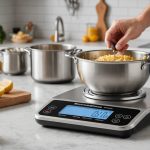Importance of Ergonomic Kitchen Design
When crafting a kitchen space, ergonomic kitchen design is pivotal to ensure functionality and comfort during meal preparation. A well-thought-out ergonomic design integrates crucial elements like cooktop placement and oven placement, affecting cooking efficiency and user satisfaction. Proper placement not only facilitates smooth workflow but also reduces unnecessary movements, enhancing overall cooking experience.
Effective cooktop placement is vital in ergonomic kitchen design. It should allow easy access, minimizing strain and allowing cooks to move fluidly between tasks. Similarly, oven placement should be strategic, ensuring that it is neither too high nor too low, promoting ease of use and preventing injuries.
Also to see : How kitchen cabinet colors influence your mood and foster healthier eating habits
The relevance of ergonomic design goes beyond functionality. It directly influences comfort and safety, offering a space where cooking becomes not just a chore, but a pleasant experience. Ergonomic designs consider the height, reach, and movements of the user, aiming to create a harmonious and efficient cooking environment. Emphasizing such elements demonstrates how ergonomic design can transform kitchen functionality, making day-to-day activities more enjoyable and less physically demanding. By prioritizing these principles, one can effectively enhance the ergonomic value of any kitchen space.
Guidelines for Cooktop Placement
Cooktop positioning plays a crucial role in creating a functional and safe kitchen environment. Optimal placement involves ensuring the cooktop is at a comfortable height to facilitate easy access without excessive bending or reaching. The ideal position typically follows the ergonomic triangle principle, which places the cooktop between the fridge and sink, allowing smooth movement between tasks.
In parallel : Revamp Your Culinary Space: Elevate Self-Awareness and Nutrition with a Full-Length Mirror
Cooktop accessibility is essential for safe cooking practices. Positioning the cooktop within reach of necessary utensils and ingredients reduces unnecessary movement and potential hazards. A recommended distance is approximately 40-60 cm from the nearest countertop edge, avoiding congestion in high-traffic areas of the kitchen.
Additionally, safe cooking practices emphasize the importance of sufficient space around the cooktop. This ensures clear visibility and easy access, minimizing the risk of accidents. Incorporating a heat-resistant backsplash protects walls from heat damage and allows for easy cleaning.
Considering these ergonomic guidelines not only enhances cooking efficiency but also encourages healthier cooking practices. By promoting convenience and safety, proper cooktop placement contributes to a positive and enjoyable culinary experience, fostering an environment where creativity and safety harmoniously coexist.
Strategies for Oven Placement
A well-executed oven location strategy enhances kitchen workflow by making cooking tasks more intuitive. Best practices include positioning the oven at eye level, which reduces the need to bend and reach, minimizing strain and preventing injuries. For a seamless kitchen workflow, it’s essential to place the oven within close proximity to the cooktop and primary preparation areas. This minimizes unnecessary movements while transferring dishes.
Effective baking ergonomics involves ensuring that oven controls are easy to reach and manipulate. In smaller kitchens, wall-mounted ovens or ovens incorporated into cabinetry can maximize space while maintaining accessibility. Larger kitchens might benefit from double oven placements, which can accommodate multiple cooking tasks simultaneously without stealing valuable counter space.
When placing ovens, consider innovative configurations, such as combining microwaves or extra storage in the same vertical zone, to streamline activities further. This spatial integration exemplifies how thoughtful oven placement can significantly influence both cooking enjoyment and efficiency. Leveraging ergonomic design principles can transform the static act of baking into a more dynamic and engaging experience, fostering comfort and ease.
Integrating Kitchen Layout with Ergonomics
Understanding the significance of ergonomic kitchen layouts involves examining how they influence cooking flow. By incorporating ergonomic principles, kitchens can be tailored to support fluid and efficient movements. This ensures that essential elements like cooktops, sinks, and ovens are strategically arranged to minimize unnecessary walking and reaching, promoting a seamless cooking experience.
The concept of the triangular kitchen design is pivotal. It establishes an efficient route between the three main workstations: the cooktop, the sink, and the refrigerator. This layout not only optimizes space use but also significantly reduces the physical effort needed, enhancing the kitchen’s overall ergonomics.
However, common mistakes can disrupt this ergonomically effective design. For example, placing major appliances too far apart can lead to fatigue, while insufficient counter space can impede preparatory tasks. Ensuring an ergonomic layout is crucial to maximizing usability and minimizing strain during meal preparation.
By adhering to these principles, kitchens can offer a balanced environment that fosters both comfort and efficiency, allowing users to focus on the art of cooking rather than the obstacles posed by a poorly planned layout.
Promoting Healthier Cooking Habits Through Design
A thoughtfully designed kitchen can profoundly influence healthier cooking behaviours by shaping the kitchen environment to support nutritious meal preparation. An efficiently arranged kitchen not only facilitates smooth movements but also encourages cooks to embrace more wholesome practices. For instance, having fresh produce visible and within reach can promote healthier choices during meal prep.
To optimize kitchen space for healthier culinary practices, focus on strategic placement and storage solutions. Organising work zones that separate raw foods from cooked items can reduce cross-contamination, supporting safer cooking habits. Incorporating accessible shelving for health-conscious cookbooks or spice racks can inspire creativity and promote diverse, nutritious meal ideas.
Integrating multiple workspaces dedicated to different meal preparation activities encourages efficient workflow while maintaining cleanliness and order. This can include designated areas for chopping, mixing, and plating, streamlining the cooking process and reducing stress. A well-arranged kitchen invites experimentation, fostering an environment where cooking nutritious meals becomes a joyful part of daily life, ultimately promoting a healthier lifestyle. Prioritizing ergonomic design and organization helps ensure that the kitchen remains functional and enhances the overall culinary experience, allowing for inspired, healthful cooking endeavours.
Visual Examples of Optimized Kitchen Designs
Delving into kitchen design examples unveils the transformative power of ergonomic concepts. Each layout aligns with practical methodologies, ensuring both efficiency and aesthetic appeal. Let’s explore some detailed layout diagrams that highlight how effective alignment of kitchen elements can significantly enhance the user experience.
When you observe designs that prioritize the triangular kitchen design, it’s clear how they create a harmonious flow by minimising unnecessary steps. These diagrams emphasise the importance of proximity between major appliances, such as the cooktop and oven, alongside preparation areas, to foster an efficient cooking flow.
Incorporating various configurations, these visual examples embrace differing kitchen dimensions. You’ll find layouts ideal for compact spaces, employing vertical storage solutions and creative oven placement. Conversely, larger kitchens maximize their expanse by introducing different work zones. This division not only eases meal prep but also encourages seamless teamwork in multi-cook scenarios.
Furthermore, engaging case studies on successful kitchen redesigns demonstrate real-life applications of these principles. By highlighting tangible benefits, they serve as inspiring references for anyone considering renovations. Each example embodies the essence of ergonomic efficiency, paving the way for an enjoyable and effective culinary journey.











